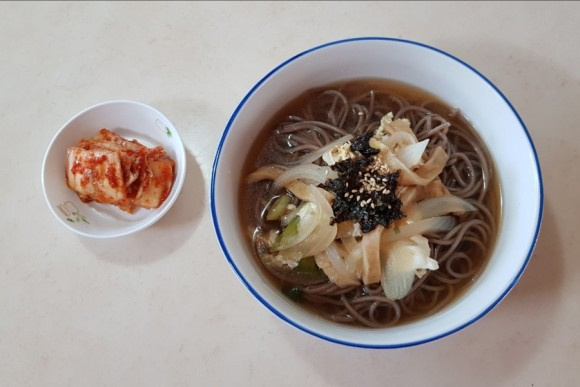Warm Buckwheat Noodles
Heartwarming Buckwheat Noodles Perfect for Chilly Autumn Days

As the crisp autumn air arrives, bringing with it clear skies and a refreshing chill, warm and comforting food becomes a true delight. This recipe for ‘Warm Buckwheat Noodles’ is a perfect way to embrace the season, especially if you have some leftover soba noodle broth. Using a store-bought soba broth base, you can easily achieve a rich and savory flavor that complements the delicate taste of buckwheat noodles. This detailed guide will walk you through each step, ensuring even beginners can create a deeply satisfying and nourishing bowl of noodles. Let’s make your autumn days warmer and tastier!
Essential Ingredients- Buckwheat noodles: 3 handfuls (about the size of 3 US quarter coins)
- Store-bought soba noodle broth (Tsuyu or mentsuyu): To taste
- Egg: 1
Cooking Instructions
Step 1
First, fill a large pot with plenty of water for cooking the noodles and bring it to a boil over high heat. While the water heats up, prepare another pot for the broth.
Step 2
In the pot designated for the broth, combine water and the store-bought soba noodle broth. Stir well. Since the saltiness of soba broths can vary, it’s best to start by adding the broth a spoonful at a time and tasting as you go. Aim for a slightly milder flavor initially, as the broth’s intensity will increase as it simmers. Adjust the seasoning to your preference.

Step 3
Once the broth starts to simmer, add the thinly sliced onion, chopped scallions, and sliced fish cakes. Cook for about 2-3 minutes, just until the onions become translucent and tender. This allows the natural sweetness of the vegetables and fish cakes to infuse the broth.

Step 4
In a small bowl, crack one egg and add a pinch of salt. Lightly whisk the egg until the yolk and white are just combined. Avoid over-whisking.

Step 5
While the broth is simmering, slowly drizzle the whisked egg into the pot in a circular motion using a ladle or spoon. As soon as the egg begins to set into delicate ribbons, turn off the heat immediately. The key is to cook the egg just enough without overcooking it.

Step 6
When the water for the noodles is at a rolling boil, carefully add the buckwheat noodles.

Step 7
The cooking time for buckwheat noodles can vary depending on the brand, but typically 6-7 minutes is sufficient. Once the noodles are in and the water returns to a boil, foam will start to rise. Similar to cooking soba noodles, add about 1/2 cup of cold water to calm the foam. Repeat this process once or twice more. This technique helps the noodles cook evenly and achieve a wonderfully chewy texture. (Always refer to the package instructions for the most accurate cooking time.)

Step 8
Once the noodles are cooked to your liking, drain them and rinse thoroughly under cold running water 2-3 times. This removes excess starch and helps maintain the noodles’ firm texture.

Step 9
Drain the rinsed noodles well in a colander. Ensure that most of the water has dripped off, as excess water can dilute the flavor of the broth.

Step 10
Arrange the drained buckwheat noodles attractively in serving bowls. Ladle the hot broth and the cooked ingredients (onions, scallions, fish cakes) generously over the noodles.

Step 11
Finally, garnish with a sprinkle of toasted sesame seeds and shredded seaweed. For a touch of spice, feel free to add a pinch of red pepper flakes according to your preference. Enjoy your comforting bowl of warm buckwheat noodles and chase away the autumn chill!




